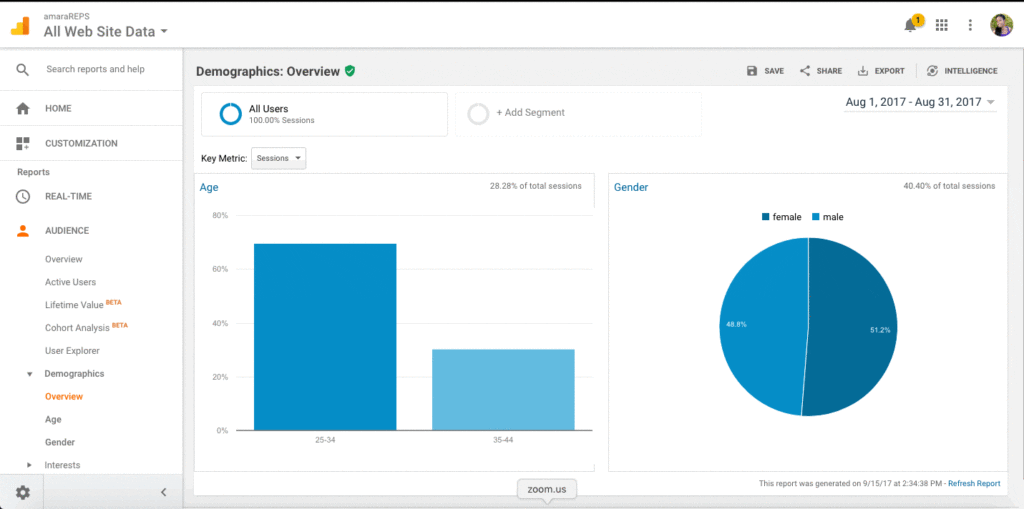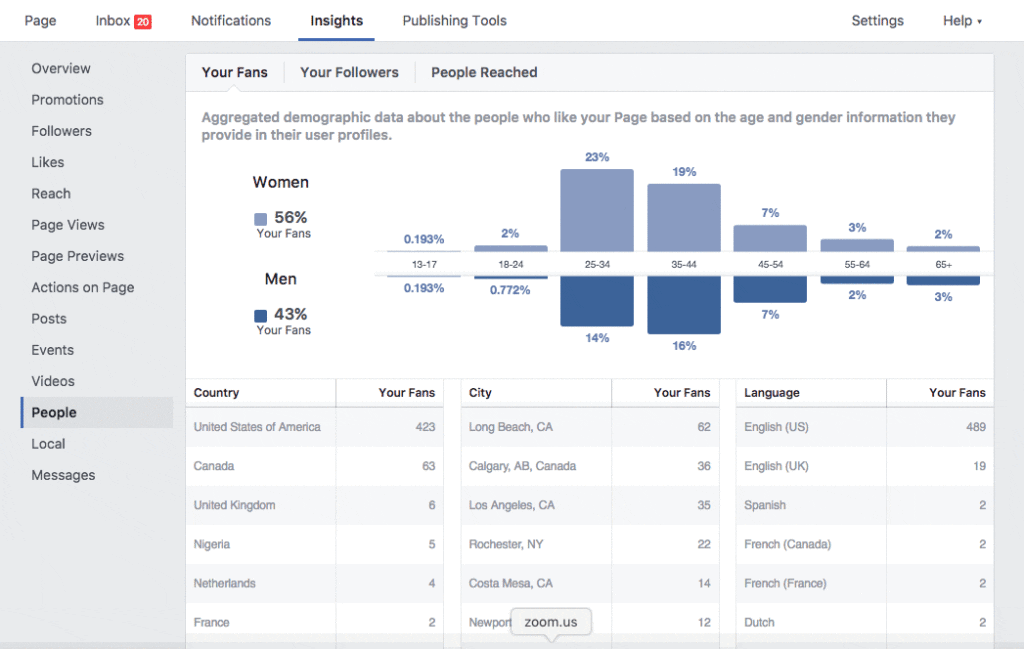I’m sure you’ve noticed that it’s become increasingly difficult to be heard amongst all the noise out there. Businesses large and small are competing for millions of potential customers that are searching for and engaging with content daily… and of course the green in their wallets.
In some cases, this struggle has created a divide between the haves and the have-nots where the playing field is seemingly tipped in favor of businesses that have large budgets, big marketing teams, and technical know-how.
As with anything, there’s a way around all of these disadvantages for new and small business owners who are seemingly at a disadvantage.
Start with the basics: getting to know who your customers are
I was at a SCORE.org workshop about 10 years ago listening to a marketing expert talk about advertising strategy for huge companies like Nissan. He asked a very interesting question:
“Can you tell who Nissan’s target audience is by looking at their commercials? If so, who are they targeting?”
We all guessed, and the odd part is that we were all correct. Back then, they were targeting EVERYONE (and they still might be today).
What he had just said forever shaped how I approached marketing for my clients.
You see, big companies have HUGE budgets. They fish with a big net and they get more of what they want, than what they don’t want… for example:
- Brand Awareness
- Customers
- Credibility
…you get the idea.
Small businesses have to be more deliberate with how they invest their time and money; in order to do so effectively, you have to first know who your customers are and then target them consistently.
Demographics: Your Customer’s Profile
Identifying and defining your customer(s) common socioeconomic characteristics including but not limited to:
- Gender
- Age
- Income
- Location
- Education
- Marital Status
Have you noticed companies aggressively prompting you to take surveys? Ever wonder why they ask the questions that they do? We assure you that the questions are very intentional and that companies who plead with you to engage with those surveys are doing so for good reason. The information that they are gathering from you is gold.
When you volunteer information about yourself, like the bullet points above, your information helps determine where companies will advertise and spend their marketing efforts. Typically companies will survey their current customers to determine commonalities, anomalies, and identify changes in the behavior of their consumers over different periods of time. This information helps companies better understand different consumer segments. Having this information allows businesses to hone their messaging by having a better understanding of their target audience (those most likely to purchase based on the demographic data collected). Allowing companies to create more content catered to the needs, wants, and interests of their target audience which will more than likely yield favorable response and engagement. The information also enables marketers to better identify the proper channels for promotions and advertising campaigns as well.
Here’s how to gather demographic information on your current and potential customers.
- Survey them. Send them a short survey to determine baseline demographic information of your current customers. Why? So that you can attract more people like them.
| Tip: Incentivize them with a discount code or free gift to get more responses. This information is golden, so you’ll want to get as many honest responses as possible. Also, survey frequently (at least once a year, or once a quarter if you can do so without annoying your customer base). By doing so, you may notice new trends or identify key changes in your customer base before it’s too late. |
- Google Analytics. Did you know that Google Analytics reports the demographic information of the people who visit your website? You can also drill down to identify basic demographic information for various segments of visitors like people who have purchased a product or completed a pre-defined action like submitting their information via a contact form.
 Also, Google Analytics interest and affinity reports are a powerful tool for understanding common interests in your audience. Within this report, you’ll be able to determine the similar interests that your visitors share with the people who have converted on your website. Use this information for your remarketing/retargeting campaigns, and to help inform your marketing efforts in general.
Also, Google Analytics interest and affinity reports are a powerful tool for understanding common interests in your audience. Within this report, you’ll be able to determine the similar interests that your visitors share with the people who have converted on your website. Use this information for your remarketing/retargeting campaigns, and to help inform your marketing efforts in general.
| Tip: You have to turn this capability on in your Google Analytics dashboard in order to see this data. Here’s how to enable demographics and interest reports. |
- Facebook Insights. Are you attracting your target demographic on Facebook? Is your content resonating with them? To answer these questions, check out your insights report on Facebook, and have a look at how everything breaks down. Facebook is constantly changing, and we don’t have much control over what’s under the hood, so I’d put it on your calendar to review your stats once a month or at the very least once a quarter.

|
Tip: Facebook Insights aren’t all that intuitive, so let me help you out. Here are the places that you want to look for demographic information:
|
- Market Research. Whether you are starting a new business or trying to grow an existing one, you can benefit from current market research and demographic information that pertains to your industry.
Luckily, there are many companies dedicated to compiling demographic information for various industries, which do often come at a price. Keep in mind that these research companies are surveying hundreds, or even thousands of consumers, that purchase within a given industry or that fit within a specific buyer persona (also known as a customer avatar), so these reports contain information about your competitors’ customers as well. I say this to provide fair warning that some of these reports can cost thousands of dollars to obtain, and rightfully so.There are ways; however, to obtain some of the information inside of industry reports if you aren’t able to foot the bill at your moment of need. The research companies that publish the reports occasionally release little snippets of these reports as a teaser. Sometimes, a marketer who has purchased the information will release bits and pieces of these reports in order to summarize changes within the industry.You may have noticed that when you read a whitepaper or blog post that contains very specific statistical information, the expert will typically reference an industry report to substantiate their claims or provide context to the subject matter.
Whether in part or in whole, these insights are very helpful and can help you better understand how your industry or certain markets are trending. Purchase a report if you can, and if you aren’t able to, Google is your friend.
Also… many independent companies conduct proprietary research and publish their findings for free. So if your budget doesn’t allow for a spendy industry report, and if you don’t have access to a large enough sample to conduct your own research, give up your email to download one of the free ones that are out there. These independent studies typically aren’t as comprehensive, but it’s a good place to start and could save you a ton of time (and money in some cases) from having to conduct the research on your own.
- Check out your competitors. Have you seen your competitors go after a new market recently? Do you notice a change in the way that they advertise, or who they target and how? That’s probably because they’ve identified an additional market segment that works for them. Now, the question is… will that market segment respond similarly to you?
Researching your competitors is a good idea for many reasons; however, it is not a license to copy them… just so we’re clear. The questions that you want to ask when researching your competitors may include…- Are there problems that are not being solved within your respective industry that you may be able to provide solutions for?
- What are some of their audiences biggest complaints about your competitors?
- What are some of the opportunities within the market?
| Tip: There’s all sorts of tools that you can use to spy on your competitors. Some are free, most of them are paid.
FREE(ish)*: Alexa.com tracks all sorts of information across the web, and it estimates traffic information similar to what you would find on the audience tab of Google Analytics. You can see your competition’s demographic information within Alexa, which should give you some insight on how to approach reaching your target consumers. *You can get a 7-day trial, and SOME of the information that Alexa provides is free without a subscription. PAID: Demographicspro.com is a very indepth paid tool that aggregates reports of demographic information of social profiles. This could be quite handy if you intend to use influencer marketing as a strategy, and want to see what demographics a user’s profile has before investing in them to promote your products/services. |
Psychographics: How Your Customer’s Decide to Purchase
I always say that good, quality marketing is driven by equal parts data insights and psychology. While it is extremely important to understand who your customers are, knowing why they purchase tells the whole story.
In fact, when creating your buyer personas, I encourage our clients to write a short story about their ideal customer to help personify this fictitious person and get into their head a bit in terms of the following:
- What do they want more of?
- What pain are they having that you can ease?
- What motivates them to purchase?
- What turns them off?
- What are their habits?
- What do they value?
Let’s say that you are a business coach looking for new clients. You’ve identified that your ideal client is a female business owner who is between 40 and 50 years old. She has been in business for over 10 years, and grosses over $2,000,000 annually in revenue.
Now that you’ve uncovered her basic demographic information, let’s finish the story with her psychographics.
First, let’s give her a name: Grace.
Grace has a team of 10 people and just can’t seem to figure out how to break past the $2,000,000 gross revenue mark for her business. She has turnover issues and feels that may have stunted her company’s growth because she constantly has to retrain people in key positions. Her team isn’t as productive as she’d like them to be… or so she thinks. She really has no way of proving it, but she just doesn’t feel like she’s getting her money’s worth out of the people that she’s hired. She feels like she’s spinning her wheels but, at the end of the day, she is an extremely gifted interior designer. That’s where her genius lies. She just hasn’t quite grasped the business side of things in 10 years for whatever reason..
As a business coach, you could write an entire story about the pain this woman is feeling in her business, and how your business can help her. This is where the psychographic magic happens. You now have a better understanding of why your target customer is deciding to purchase so that you can get your product in front of her and attract her based on her needs and reasons.
Gaining Psychographic Insights on Your Customers
I’d like to argue (based on my own personal observations) that some of the most valuable psychographic information isn’t communicated via Q&A, but through buyers’ behaviors that they aren’t even conscious of. When I’m conducting psychographic research, I often write out my questions and my assumptions beforehand. Most of those assumptions are based on my observation of consumer behaviors and other correlative data.
When surveyed, consumers may have a hard time recounting, or communicating, what influenced their decision and/or lead to their purchase. Which is why, sometimes, a mix of true/false questions and free form text responses can help you confirm or debunk any assumptions about what influenced their purchasing path without leaving it up to the consumer to re-draw that picture for you.
Segmenting Your Customers into Audiences Based on Demographics
Once you have your psychographic and demographic information, you’ll want to create buyer personas/customer avatars (fictitious representations of people who fit a specific data set that has sets of common traits).
3 Ways to Create Avatars
- Draw it out. If you are more artistically inclined, you may choose to print out pictures or create a vision board of each of your customer personas that shows a visual representation of the information. While this may be good documentation method for your learning style, it may not be effective for a team to reference if there isn’t enough context.
- Write it out. Similar to my example above, you can write descriptive profile that can be as long or short as you want it to be. Sometimes, the free flow of thoughts and ideas about your customer can create some really great ideas for content and really help you understand and even feel the pain that you target audience feels without having your solution to their pain. When you’re writing, be sure to include how your solution makes them feel after they’ve solved their problem, as it will bring everything full circle.
- Use a template. There are several components to creating a complete buyer persona. If you work with a team, using a template for each avatar is ideal so that you have specific information for each avatar, and you can ensure that you are identifying information consistently across each avatar. Templates are also usually easier to read than long form stories and have more context than a drawing. I highly recommend using a template to complete this exercise, just be sure that you revisit your avatars quarterly in case new ones pop up, or yours change for whatever reason.
This exercise will help you apply demographics and psychographics to your messaging so that your marketing is more effective. By segmenting your messaging and addressing the specific needs of your audiences, your marketing will likely resonate with your target audience. It will also stand out from your competitors who haven’t taken the time to get to know their customers and address their needs, concerns, and motivations. It’s like you’re speaking directly to them versus shouting from the rooftop to an entire city and hoping the right people hear it.
Need a template? We’ve created a handy workbook and template that you can use to complete your avatars.
[ut_button color=”theme-btn” target=”_blank” link=”http://info.amarareps.com/buyer-persona-pdf” size=”small” ]Click here for a free download[/ut_button]

